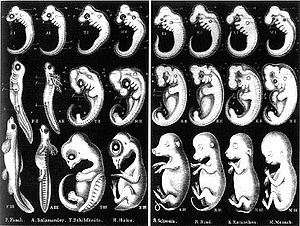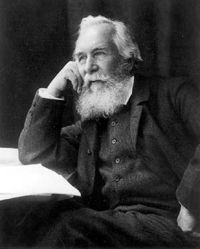Haeckel Diagrams
 From Conservapedia
From Conservapedia 
For over a century, school textbooks taught students that the Theory of Evolution was illustrated by similarities between the development of a human in the womb compared to the shape of embryos of lower life forms.[1] In other words, human development supposedly imitated the evolutionary path of life on earth.
This theory was initially proposed by Charles Darwin in The Origin of Species and then heavily promoted by the German Darwinist, Ernst Haeckel. In 1904, Haeckel reiterated a view of Darwin: "These lower races ... are psychologically nearer to the mammals (apes or dogs) than to civilized Europeans; we must, therefore, assign a totally different value to their lives." [2]
Haeckel drew diagrams suggesting that an animal, including a human, imitates the shapes of its ancestors' evolution as it develops in the womb. He then drew fraudulent images to popularize his theory. The drawings, shown to the right here, were a complete fake.[3]
The Haeckel diagrams remained in school textbooks long after scientists privately recognized they were fraudulent. The diagrams were not removed from textbooks until the New York Times publicized the fraud in 2001.[4]

Noted evolutionist Stephen Gould wrote the following regarding Ernst Haeckel's work in a March 2000 issue of Natural History:
| “ | "Haeckel’s forceful, eminently comprehensible, if not always accurate, books appeared in all major languages and surely exerted more influence than the works of any other scientist, including Darwin…in convincing people throughout the world about the validity of evolution... Haeckel had exaggerated the similarities [between embryos of different species] by idealizations and omissions. He also, in some cases — in a procedure that can only be called fraudulent — simply copied the same figure over and over again.…Haeckel’s drawings never fooled expert embryologists, who recognized his fudgings right from the start. Haeckel’s drawings, despite their noted inaccuracies, entered into the most impenetrable and permanent of all quasi-scientific literatures: standard student textbooks of biology... Once ensconced in textbooks, misinformation becomes cocooned and effectively permanent, because…textbooks copy from previous texts.... [W]e do, I think, have the right to be both astonished and ashamed by the century of mindless recycling that has led to the persistence of these drawings in a large number, if not a majority, of modern textbooks!"[5] | ” |
Even after creationists repeatedly pointed out the fraudulent nature of these drawings, the evolutionists continue to use them in biology exams to this day. The biology paper in the Higher School Certificate exam on 19 October 2012, a major public matriculation exam in New South Wales, Australia, contained a question featuring Haeckel's fraudulent embryo drawings.[6]
Stephen Gould continues by quoting Michael Richardson of the St. George's Hospital Medical School in London, who stated: "I know of at least fifty recent biology texts which use the drawings uncritically".[7]
Creationists have written regarding the fraudulent nature of Haeckel's work and how a prestigious German science journal published his dubious work.[8][9]
Ernst Haeckel attempted to portray himself as an ethical proponent of atheism, however, history shows he was a deceitful atheist.[10][11][12] [13][14] The March 9, 1907 edition of the NY Times refers to Ernst Haeckel as the "celebrated Darwinian and founder of the Association for the Propagation of Ethical Atheism."[15]
See also[edit]
- Theory of Evolution and Cases of Fraud, Hoaxes and Speculation
References[edit]
- ↑ https://www.nytimes.com/2001/04/08/science/08EVOL.html?ex=1184644800&en=b264988a2bf17108&ei=5070
- ↑ Ernst Haeckel, The Wonders of Life (New York: Harper 1904), 56-57 (emphasis added).
- ↑ http://www.truthinscience.org.uk/site/content/view/49/65/
- ↑ James Glanz, "Illustrations More Fiction Than Fact," New York Times (April 8, 2001).[1]
- ↑ http://www.creationism.org/caesar/haeckel.htm
- ↑ https://creation.com/biology-exam-fraud
- ↑ http://www.creationism.org/caesar/haeckel.htm
- ↑ http://www.answersingenesis.org/creation/v18/i2/haeckel.asp
- ↑ http://www.creationontheweb.com/content/view/747
- ↑ "Another Evolution Fraud Exposed" - Creationism.org, INVESTIGATING GENESIS SERIES.
- ↑ http://query.nytimes.com/gst/abstract.html?res=9C03EFDD123EE033A2575AC0A9659C946697D6CF
- ↑ http://www.discovery.org/scripts/viewDB/index.php?command=view&id=1180
- ↑ http://www.iconsofevolution.com/Icons of Evolution
- ↑ http://www.discovery.org/articleFiles/PDFs/survivalOfTheFakest.pdf
- ↑ http://query.nytimes.com/gst/abstract.html?res=9C03EFDD123EE033A2575AC0A9659C946697D6CF
| |||||||||||
Categories: [Evolution] [Theory of Evolution and Cases of Fraud, Hoaxes and Speculation] [Liberal Falsehoods]
↧ Download as ZWI file | Last modified: 02/08/2023 19:22:39 | 40 views
☰ Source: https://www.conservapedia.com/Haeckel_diagrams | License: CC BY-SA 3.0
 ZWI signed:
ZWI signed: KSF
KSF